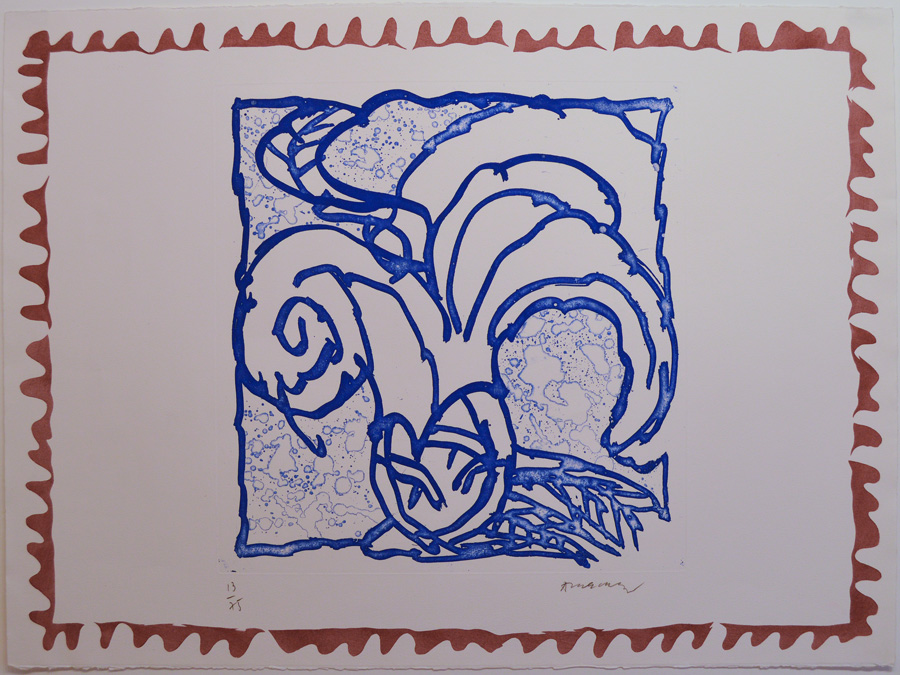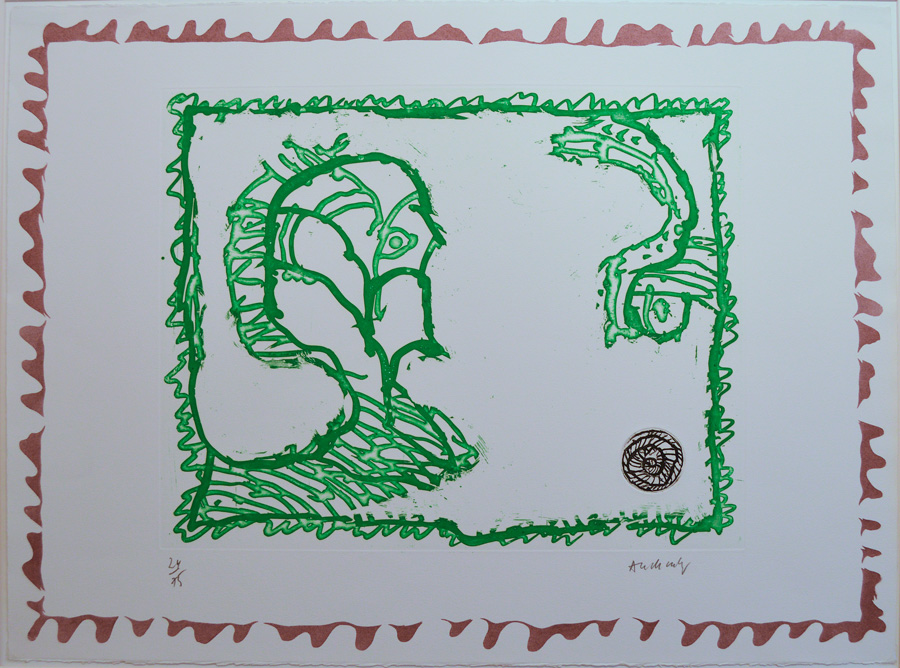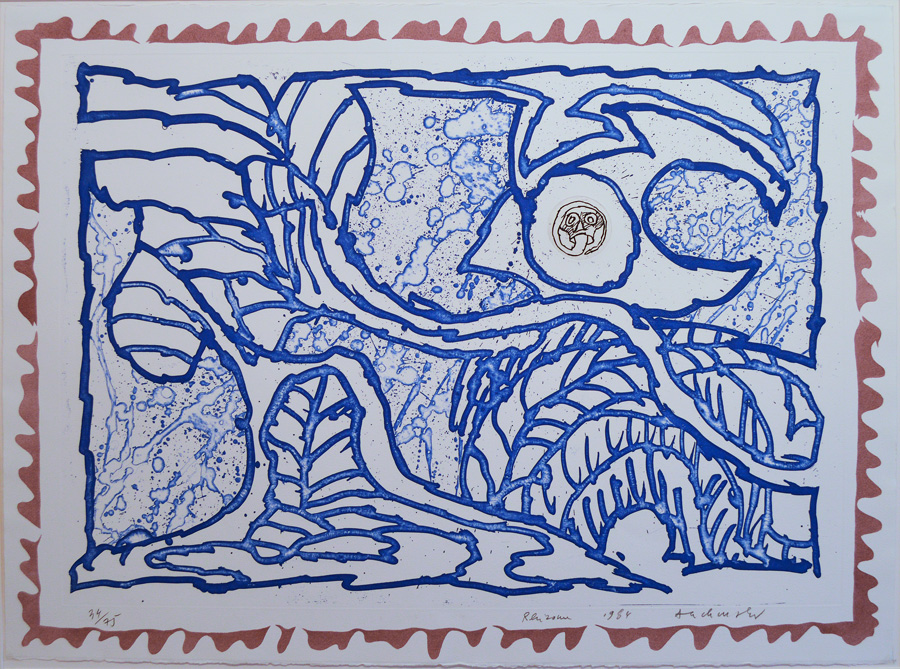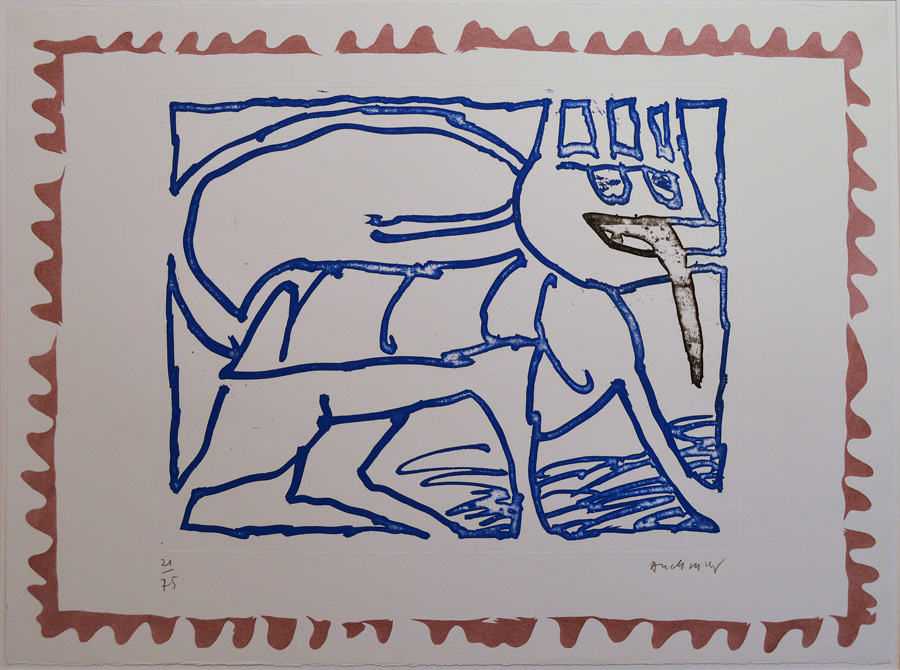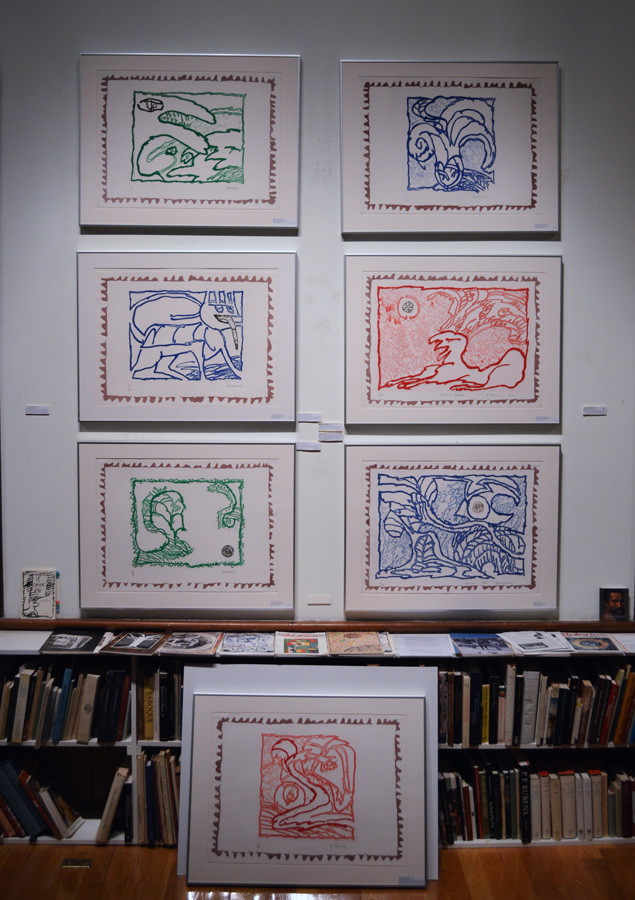The winner of the first Andrew W. Mellon Prize for Painting (1977) and the French Grand Prix National for painting in 1984, Alechinsky has been recognized in recent years as one of the most significant living artists. (The art market has also noticed his stature: one of his paintings sold at auction about 15 years ago for over Please call or email for current pricing information,000.)
Alechinsky was just barely out of his teens when he burst onto the art scene as one of the original members of the COBRA group, and over the years he has emerged as one of the most imaginative and witty artists of our times. Alechinsky fans are everywhere. John Russell, who in 1986-87 devoted three separate columns in The New York Times to Alechinsky, sees him as "a man of strange blameless passions. Decorated invoices, worthless stock certificates, obsolete air-force navigational charts and ancient hand-written archival materials spark his imagination. . . . He has a taste for nature’s upheavals." Carlos Fuentes, the Mexican novelist for whom "the garden is the center of the world," has described Alechinsky as a man who "paints gardens. . . . He knows that the history of gardens is the history of all of us. . . . Alechinsky . . . chooses any of the forked paths of the manicured gardens at Blois or Hampton Court and then transforms them, ferociously, into the savage gardens of the primitive mind, the original unity of dream and awareness, reason and imagination, desire and reality." Indeed, it may be that it is his dream of recovering that lost unity that makes him, as The Times called him, "a poet of entanglement, [who] resolutely turns the emphasis away from himself, preferring to act rather as historian and referee than as autobiographer. . . . His touch is light, his thought rapid, his view of the world as sharp as it is benign. There is no better companion, and not many who keep us so consistently amused and are so generous with their findings."
Alechinsky has had major retrospectives at The Museum of Art, Carnegie Museum in Pittsburgh (in 1977, the Year of the Snake), the Guggenheim Museum in NY (987; it then traveled to Des Moines, Iowa, the Hannover Kunsteverin, and the Musée royal d'Art moderne in Brussels), the Palais des Beaux-Arts and the Musées Royeaux des Beaux Arts in Brussels, the Musée d'Art Moderne de la Ville de Paris and the Musée National d'Art Moderne, the Centre Pompidou in Paris, the Boymans-von-Beuningen in Rotterdam, the Louisiana Museum in Humlebaek, and museums in Aalborg, Brême, Copenhagen, Darmstadt, Des Moines, Düsseldorf, Gordes, Hanover, Marseille, Metz, Mexico City, Munich, St. Paul de Vence, Toronto, and Zurich. The most recent encyclopedic Alechinsky museum shows of which I know were held at the Galerie nationale du Jeu de Paume in Paris (1998; a modified version of this show traveled in 1999 to the Museo de Arte Contemporaneo (Monteray, Mexico), and the Museo José Luis Cuivas, Mexico City), IVAM Centre Julio González (Valencia, Spain, 2000); Alechinsky (Ostend: Musée d'art moderne, 2000), Alechinsky:Dessins de cinq décennes (Paris: Centre Georgres Pompidou, Musée national d'Art moderne, Cabinet d'art graphique, 2004), Alechinsky (Carl-Hennig Pedersen and Else Alfelt Museum, Herning, Denmark), Alechinsky de A à Y (Brussels: Royal Museums of Fine Arts of Belgium, 2007-2008: see pages 283-290 for a list of all of Alechinsky's one person shows).
Alechinsky's most recent print retrospectives were held at the Museum of Modern Art (NY, 1981; organized by the MoMA, before it came to NY, it showed at the San Jose Museum of Art, the University of Houston, The Edwin A. Ulrich Museum of Art at Whichta State University, the Art Gallery of Hamilton, Ontario, and the Montreal Museum of Fine Arts), the Centre de la Gravure et de l'image imprimiée, Musée des Beaux-Arts, Moutier, Switzaerland (1982), Litos Perpetra: Pierre Alechinsky (Museuo de Belles-Artes, Caracas, 1990), Pierre Alechinsky: Carta Canta: mostra antologica dell'opera grafica 50-90 (Bologna), "Pierre Alechinsky: Graphics Retrospective (Taipai, 1992), Alechinsky: Labor de imprenta de cinco décadas (Museo de Arte Contemporaneo y Instituto de Artes Graficas, 1996-97), Pierre Alechinsky: Noir sur Blanc 1947-1997 (Geneva, Cabinet des esampres du Musée d'Art et d'HIstoire), Alechinsky, 50 ans d'imprimerie (Centre de la Gravure et de l'image imprimée de la Comunitée Française de Belgique, La Louverie, Belgium, 2000; the show then traveled to Poznan, Warsaw, Krakow, Quebec, Metz, Riom, and the Somme), Alechinsky: obra grafica (traveling show: Institut français de Valencia, Institut français de Madrid, Institut français de Barcelona, Salamanca: Palacio de Abrantes, Universidad de Salamanca), "Alechinsky: Estampes" (Monte Carlo, 2000), Pierre Alechinsky: Estampes (Rieupeyroux, France: 2000), Pierre Alechinsky, estampes, 1975-2000 (Fougères: Galerie des Urbanistes, 2000), Primeurs et retrouvilles—Lithographies de Pierre Alechinsky (Paris: Editions Ateliers Clot, 2001), Pierre Alechinsky: Morsures et autres gravures (Strasburg: Misée d'art moderne et contemporain, 2002), Pierre Alechinsky: 50 jahr grafisch werk (Wortegen, Belgium, 2002), Pierre Alechinsky: lithographies réalisées aux Éditions Atelier Clot á Paris (Aux-les Bains, Musée Faure, 2003), Pierre Alechinsky: papier, cuivre, et pierre, depuis 1947 (Auvers-sur-Oise: Musée Daubigny, 2004), Les Impressions de Pierre Alechinsky (Paris: Bibliothèque nationale dee France, 2005), Pierre Alechinsky: Encres et espampes, 1969-2004 (Nice: Galerie d'art moderne et contemporain, 2005).
Select Bibliography: General works: Daniel Abadie and Willy Van Den Bussche, Pierre Alechinsky (Ostend: PMMK, 2000); Pierre Alechinsky, Cent vingt dessins, donation de l'artiste (Brussels: Musees Royaux des Beaux-Arts de Belgique, Brussels 1973); Pierre Alechinsky, Divers faits (Vevey: Musee Janisch, 2000); Pierre Alechinsky, Au Pays de l'encre (Paris: Centre Pompidou, 1998), Pierre Alechinsky, Dotremont et Cobra-foret (Paris: Galilee, 1988); Pierre Alechinsky, Drawings and Prints (Jerusalem: Musee d'Israel, 1970); Pierre Alechinsky, Hoirie Cobra (Caen: L'Échoppe, 1990); Pierre Alechinsky, Ideotraces (Paris: Editions Denoel, 1966); Pierre Alechinsky, Le bureau de titre (Paris: Fata Morgana, 1983); Pierre Alechinsky, Le test du titre: 6 planches et 61 titreurs d'elite (Paris: Yves Riviere Editeur, 1974); Pierre Alechinsky, Margin and Center (NY: Solomon R. Guggenheim Foundation, 1987); Pierre Alechinsky, New Work: Pains de terre émaillé, Flora Danica drawings, Revalorisations (NY: Andre Emmerich Gallery, 1991); Pierre Alechinsky, Notes sur Orsay (Caen: L'Échoppe, 1989); Pierre Alechinsky, Paintings and Writings (Pittsburgh: Museum of Art, Carnegie Institute, 1977); Pierre Alechinsky, Pierre Alechinsky: Werke 1958-1968 (Düsseldorf. Kunstverein fur die Rheinlande und Westfalen, 1969); Pierre Alechinsky, Reponses á un questionnaire (Caen: L'Echoppe, 1987); Pierre Alechinsky, The Future of Property. Fourteen Specimens re-evaluated by Pierre Alechinsky (NY: Lefebre Gallery, 1970); Pierre Alechinsky and Georges Duby, Alechinsky (Zurich: Maeght Zurich, 1980); Pierre Alechinsky, and Amos Kenan, Les Tireurs de Langue (Paris: Yves Riviere Editeur, 1974); Pierre Alechinsky and Karel Appel, Two-brush paintings. Their Poems by Hugo Claus. Foreword by Christian Dotrement (Paris: Yves Riviere Editeur, 1980); Karel Appel & Pierre Alechinsky, Encres á deux pinceaux (Paris: Yves Riviere Editeur, 1978); Alain Bosquet, Alechinsky (Paris: Le musée de poche 1971); Jacques Busse, Pierre Alechinsky (Chicago: Arts Club Of Chicago, 1965); Pierre Descargues, Alechinsky Bouches et Grilles (Paris: Galerie Maeght Lelong 1986); Christian Dotrement et al., Appel et Alechinsky: Encres à deux pinceaux, peintures, etc. (Saint Paul De Vence: Fondation Maeght, 1982); Georges Duby, Alechinsky (Zurich: Maeght Zurich 1980); Jacques Dupin, Alechinsky: Laves Emaillees (Paris: Galerie Lelong, 1988); Petit journal: Made in France 1947-1997 (Paris: Centre Pompidou, 1997); Jacques Putnam, Alechinsky (Paris: Celiv, 1990); Alain Robbe-Grillet, Pierre Daix et al., Pierre Alechinsky (Valencia: IVAM Centre Julio Gonzalez, 2000); Alain Robbe-Grillet, John Yau, Daniel Abadie and Pierre Daix, Pierre Alechinsky (Paris: Jeu de Paume, 1998); Michel Sicard, Alechinsky Sur Rhone (Paris: Galerie Lelong, 1990); Michel Sicard, ed. Pierre Alechinsky: Extraits pour traits (Paris: Galilée, 1989); Giorgio Soavi, Alechinsky: XXXVI Biennale de Venise, Pavillon Belge (Venice: Venice Biennale, 1972).
Prints: Pierre Alechinsky, Alechinsky a l'imprimerie: 150 estampes (Paris: le Musee national d'art moderne, 1975, 1977); Pierre Alechinsky, Alechinsky (Rome: Edizioni 2RC, 1988); Pierre Alechinsky, Aux petits soins (Paris: Atelier Clot, 1989); Pierre Alechinsky, Ces robes qui m'evoquaient Venise. (Montpellier: Fata Morgana, 1988); Pierre Alechinsky, L'avenir de la propriéte (Montpellier: Fata Morgana, 1992); Pierre Alechinsky, Communication: 16 Manifestations d'Hypertrophie Calligraphique (Vouvière (Belgique): Editions du Daily-Bul, 1967); Pierre Alechinsky et al., The Complete Books: A Reasonable Catalogue (Antwerpen: Ceuleers & Van de Velde, 2002); Pierre Alechinsky and Michel Butor, Le Chien Roi (Paris: Daniel Lelong Editeur, 1984); Franck Bordas et al, Les Impressions de Pierre Alechinsky (Paris: Bibliothèque nationale de France, 2005); Michel Butor et Michel Sicard, Pierre Alechinsky: Frontières et Bordures (Paris: Editions Galilee, 1984); Michel Butor et Michel Sicard, Alechinsky: Travaux d'Impression (Paris: Editions Galilee, 1992); Michel Draguet et al., Alechinsky from A to Y (Tielt, Belgium: Lannoo, 2007); Rainer Michael Mason et al, Pierre Alechinsky: Noir sur blanc (Geneva: Caninet des Estampes du Musee D'Art et D'Histoire, 1998); Yves Riviere, Pierre Alechinsky: Les estampes de 1946 a 1972 (Paris: Yves Riviere Editeur, 1973).
|
|
